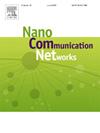Energy harvesting-based thermal aware routing protocol for lung terahertz nanosensor networks
IF 4.7
4区 计算机科学
Q2 ENGINEERING, ELECTRICAL & ELECTRONIC
引用次数: 0
Abstract
Lung damage caused by viral infections such as COVID-19, MERS, and SARS can lead to serious or even fatal conditions. Therefore, monitoring lung diseases at the nanoscale has great potential for development. Some biomedical sensors implanted in the human body can generate electromagnetic radiation, and excessive emission power may pose a serious threat to tissues in the human body. Therefore, while constructing lung wireless nanosensor network (WNSN), we need to consider the limited energy storage and potential thermal effects of nanosensors. In this paper, an energy harvesting-based thermal aware routing (EHTAR) protocol is proposed. The protocol introduces a piezoelectric energy harvesting system to charge the nanonodes and proposes a sleep-wake mechanism for node temperature and energy to establish a next-hop link cost function using node temperature, remaining energy, and distance as cost factors. Simulation results demonstrate that EHTAR makes the node temperature not exceed the set threshold and the energy harvesting mechanism can greatly extend the network survival, so EHTAR can be better applied in the lung health monitoring scenario.
基于能量采集的肺太赫兹纳米传感器网络热感知路由协议
由COVID-19、中东呼吸综合征和SARS等病毒感染引起的肺损伤可导致严重甚至致命的疾病。因此,在纳米尺度上监测肺部疾病具有很大的发展潜力。一些植入人体的生物医学传感器会产生电磁辐射,发射功率过大可能会对人体组织造成严重威胁。因此,在构建肺部无线纳米传感器网络(WNSN)时,需要考虑纳米传感器有限的能量存储和潜在的热效应。提出了一种基于能量采集的热感知路由(EHTAR)协议。该协议引入压电能量收集系统对纳米节点进行充电,并提出节点温度和能量的睡眠-觉醒机制,以节点温度、剩余能量和距离为成本因素建立下一跳链路成本函数。仿真结果表明,EHTAR使节点温度不超过设定的阈值,能量收集机制可以大大延长网络生存期,因此EHTAR可以更好地应用于肺部健康监测场景。
本文章由计算机程序翻译,如有差异,请以英文原文为准。
求助全文
约1分钟内获得全文
求助全文
来源期刊

Nano Communication Networks
Mathematics-Applied Mathematics
CiteScore
6.00
自引率
6.90%
发文量
14
期刊介绍:
The Nano Communication Networks Journal is an international, archival and multi-disciplinary journal providing a publication vehicle for complete coverage of all topics of interest to those involved in all aspects of nanoscale communication and networking. Theoretical research contributions presenting new techniques, concepts or analyses; applied contributions reporting on experiences and experiments; and tutorial and survey manuscripts are published.
Nano Communication Networks is a part of the COMNET (Computer Networks) family of journals within Elsevier. The family of journals covers all aspects of networking except nanonetworking, which is the scope of this journal.
 求助内容:
求助内容: 应助结果提醒方式:
应助结果提醒方式:


